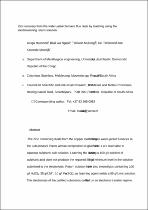 ResearchSpace
ResearchSpace
Zinc recovery from the water-jacket furnace flue dusts by leaching and electrowinning in a SEC-CCS cell
JavaScript is disabled for your browser. Some features of this site may not work without it.
- ResearchSpace
- →
- Research Publications/Outputs
- →
- Journal Articles
- →
- View Item
| dc.contributor.author |
Mukongo, T

|
|
| dc.contributor.author |
Maweja, K

|
|
| dc.contributor.author |
Wa Ngalu, B

|
|
| dc.contributor.author |
Mutombo, I

|
|
| dc.contributor.author |
Tshilombo, K

|
|
| dc.date.accessioned | 2009-10-13T13:04:44Z | |
| dc.date.available | 2009-10-13T13:04:44Z | |
| dc.date.issued | 2009 | |
| dc.identifier.citation | Mukongo, T, Maweja, K, Wa Ngalu, B et al. 2009. Zinc recovery from the water-jacket furnace flue dusts by leaching and electrowinning in a SEC-CCS cell. Hydrometallurgy, Vol. 97(1-2). pp 53-60 | en |
| dc.identifier.issn | 0304-386X | |
| dc.identifier.uri | http://hdl.handle.net/10204/3661 | |
| dc.description | Copyright: 2009 Elsevier. This is the author's version of the work. It is posted here by permission of Elsevier for your personal use. Not for redistribution. The definitive version was published in the journal, Hydrometallurgy, Vol. 97(1-2), pp 53-60 | en |
| dc.description.abstract | Zinc containing flue dusts generated during a copper matter smelting process in a water-jacket furnace was leached in a zinc electro winning return solution at 55 °C. Ninety percent of the metal was dissolved after 2 h of treatment. The leaching residues contained near 43 wt.% PbSO4. Iron was removed from leaching solutions by precipitation using a saturated lime solution at pH 3–4. The precipitate formed mainly consisted of gypsum CaSO4.2H2O. Iron and magnesium co-precipitated into a chloro-hydroxide compound. No zinc compound had co-precipitated during iron removal. Copper and germanium contents lower than 10 mg/l were achieved by solvent extraction using 10% LIX 64N and cementation. Cobalt contents lower than 1 mg/l in the solution were achieved by cementation on zinc granules for 2 h at 72 to 82 °C in presence of antimony. Cadmium contents of solutions were reduced to 10 mg/l by cementation on zinc granules at room temperature. Electrons transfer regime was identified as a limiting step during zinc electrolysis in a symmetric electrolysis current–continuous circulating system, SEC-CCS. Electrolysis current efficiency higher than 94% and 3.5 kWh/ kg of specific energy consumption was achieved under 500–600 A/m2 at 35 to 40 °C in the presence of gelatine. | en |
| dc.language.iso | en | en |
| dc.publisher | Elsevier | en |
| dc.subject | Zinc | en |
| dc.subject | Flue dusts | en |
| dc.subject | Copper matter smelting process | en |
| dc.subject | Water-jacket furnace | en |
| dc.subject | SEC-CCS cell | en |
| dc.subject | Leaching solution | en |
| dc.subject | Electron transfer regime | en |
| dc.subject | Purification | en |
| dc.subject | Electrolysis | en |
| dc.subject | Hydrometallurgy | en |
| dc.title | Zinc recovery from the water-jacket furnace flue dusts by leaching and electrowinning in a SEC-CCS cell | en |
| dc.type | Article | en |
| dc.identifier.apacitation | Mukongo, T., Maweja, K., Wa Ngalu, B., Mutombo, I., & Tshilombo, K. (2009). Zinc recovery from the water-jacket furnace flue dusts by leaching and electrowinning in a SEC-CCS cell. http://hdl.handle.net/10204/3661 | en_ZA |
| dc.identifier.chicagocitation | Mukongo, T, K Maweja, B Wa Ngalu, I Mutombo, and K Tshilombo "Zinc recovery from the water-jacket furnace flue dusts by leaching and electrowinning in a SEC-CCS cell." (2009) http://hdl.handle.net/10204/3661 | en_ZA |
| dc.identifier.vancouvercitation | Mukongo T, Maweja K, Wa Ngalu B, Mutombo I, Tshilombo K. Zinc recovery from the water-jacket furnace flue dusts by leaching and electrowinning in a SEC-CCS cell. 2009; http://hdl.handle.net/10204/3661. | en_ZA |
| dc.identifier.ris | TY - Article AU - Mukongo, T AU - Maweja, K AU - Wa Ngalu, B AU - Mutombo, I AU - Tshilombo, K AB - Zinc containing flue dusts generated during a copper matter smelting process in a water-jacket furnace was leached in a zinc electro winning return solution at 55 °C. Ninety percent of the metal was dissolved after 2 h of treatment. The leaching residues contained near 43 wt.% PbSO4. Iron was removed from leaching solutions by precipitation using a saturated lime solution at pH 3–4. The precipitate formed mainly consisted of gypsum CaSO4.2H2O. Iron and magnesium co-precipitated into a chloro-hydroxide compound. No zinc compound had co-precipitated during iron removal. Copper and germanium contents lower than 10 mg/l were achieved by solvent extraction using 10% LIX 64N and cementation. Cobalt contents lower than 1 mg/l in the solution were achieved by cementation on zinc granules for 2 h at 72 to 82 °C in presence of antimony. Cadmium contents of solutions were reduced to 10 mg/l by cementation on zinc granules at room temperature. Electrons transfer regime was identified as a limiting step during zinc electrolysis in a symmetric electrolysis current–continuous circulating system, SEC-CCS. Electrolysis current efficiency higher than 94% and 3.5 kWh/ kg of specific energy consumption was achieved under 500–600 A/m2 at 35 to 40 °C in the presence of gelatine. DA - 2009 DB - ResearchSpace DP - CSIR KW - Zinc KW - Flue dusts KW - Copper matter smelting process KW - Water-jacket furnace KW - SEC-CCS cell KW - Leaching solution KW - Electron transfer regime KW - Purification KW - Electrolysis KW - Hydrometallurgy LK - https://researchspace.csir.co.za PY - 2009 SM - 0304-386X T1 - Zinc recovery from the water-jacket furnace flue dusts by leaching and electrowinning in a SEC-CCS cell TI - Zinc recovery from the water-jacket furnace flue dusts by leaching and electrowinning in a SEC-CCS cell UR - http://hdl.handle.net/10204/3661 ER - | en_ZA |





